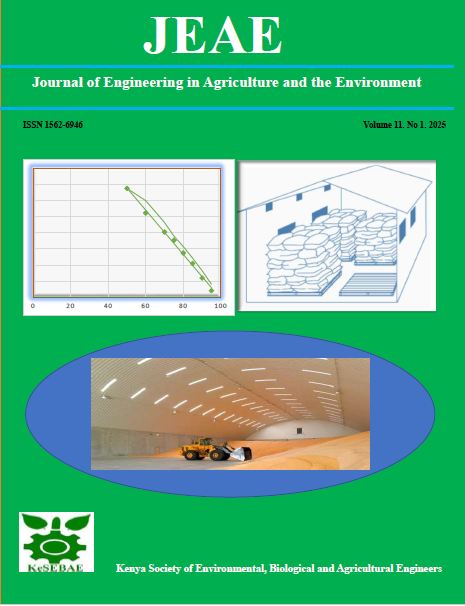Abstract
Solar-Powered Irrigation Systems (SPIS) have emerged as a sustainable solution to enhance agricultural productivity, particularly in regions facing unreliable or limited access to energy sources. By integrating photovoltaic (PV) technology with irrigation methods, SPIS provide an environmentally friendly and cost-effective alternative to conventional irrigation systems. This review synthesizes the design principles, components, operational challenges, advantages, and future developments of SPIS. This review paper was conducted using a systematic literature review approach. It evaluates case studies to assess their effectiveness in real-world applications and offers insights into overcoming the challenges associated with their deployment.
References
Pagey, A.P., Natarajan, M., Shaik, S., Gnanavendan, S. and Arıcı M. (2025). A solar-powered, internet of things (IoT)-controlled water irrigation system supported by rainfall forecasts utilizing aerosols: a review. Environ Dev Sustain. https://doi.org/10.1007/s10668-024-05953-z
Branker, K., Pathak, M. J., & Pearce, J. M. (2011). A Review of Solar Photovoltaic Levelized Cost of Electricity. Renewable and Sustainable Energy Reviews, 15(9), 4470-4482.
Burney, J., Woltering, L., Burke, M., Naylor, R., & Pasternak, D. (2010). Solar-powered drip irrigation enhances food security in the Sudano–Sahel. PNAS, 107(5), 1848-1853.
CGIAR (Consultative Group on International Agricultural Research). (2023). Solar Irrigation Pump (SIP) Sizing Tool. Decision support tool for right sizing of solar-powered irrigation pumps
FAO. (2018). The Future of Food and Agriculture – Alternative Pathways to 2050. Food and Agriculture Organization of the United Nations.
FAO. (2023). Solar-powered Irrigation: Sustainable Solutions for Agriculture.
Frauenhofer Institute. (2011). Solar Energy for Rural Electrification in Developing Countries.
Fukuda, T., Tanaka, K., & Haruna, Y. (2020). Smart control of solar-powered irrigation systems using remote sensing and data analytics. Renewable Energy, 145, 230-240. https://doi.org/10.1016/j.renene.2019.06.086
Garg, H. P., & Prakash, J. (2000). Solar Energy: Fundamentals and Applications. Tata McGraw-Hill.
GGGI (Global Green Growth Institute) 2024). Solar Powered Irrigation Systems (SPIS) Potential and Perspectives in sub-Saharan Africa. GGGI Technical Report No.39. https://gggi.org/?report=solar-powered-irrigation-systems-spis-potential-and-perspectives-in-sub-saharan-africa. Accessed on 27 March 2025
Gupta, P., Sharma, S., & Meena, S. (2021). Improving water use efficiency with solar-powered irrigation systems. Water Resources Management, 35(12), 4059-4069. https://doi.org/10.1007/s11269-021-02762-x
IEA (International Energy Agency). (2021). Renewables 2021: Analysis and Forecast to 2026. https://iea.blob.core.windows.net/assets/5ae32253-7409-4f9a-a91d-1493ffb9777a/Renewables2021-Analysisandforecastto2026.pdf. Accessed on 27 March 2025.
IEA (International Energy Agency). (2023). Advances in Solar Energy Technologies. https://www.iea.org/reports/renewables-2023. Accessed on 27 March 2025.
Kant, N., & Singh, P. (2022). Review of next-generation photovoltaic solar cell technology and comparative materialistic development. Materials Today: Proceedings, 56, 3460-3470.
Katila, P., Colfer, C. J. P., De Jong, W., Galloway, G., Pacheco, P., & Winkel, G. (Eds.). (2019). Sustainable development goals. Cambridge University Press.
Lan, C. W., Yang, C. F., Lan, A., Yang, M., Yu, A., Hsu, H. P., ... & Hsu, C. (2016). Engineering silicon crystals for photovoltaics. CrystEngComm, 18(9), 1474-1485.
López, A., Martínez, M., & Sánchez, R. (2022). Solar-powered irrigation in regions with energy scarcity: A review. Energy for Sustainable Development, 65, 12-19. https://doi.org/10.1016/j.esd.2022.02.004
Mali, S. S.; Shirsath, P. B.; Verma, Shilp; Sikka, Alok K. 2022. Solar Irrigation Pump (SIP) sizing tool: user manual (Beta version). Anand, India: International Water Management Institute (IWMI). 37p. https://dspace7test.ilri.org/items/bb6da163-d66b-41d5-882b-64862eff2237
Mann, S. A., de Wild‐Scholten, M. J., Fthenakis, V. M., van Sark, W. G., & Sinke, W. C. (2014). The energy payback time of advanced crystalline silicon PV modules in 2020: a prospective study. Progress in Photovoltaics: Research and Applications, 22(11), 1180-1194.
Milichko, V. A., Shalin, A. S., Mukhin, I. S., Kovrov, A. E., Krasilin, A. A., Vinogradov, A. V., ... & Simovski, C. R. (2016). Solar photovoltaics: current state and trends. Physics-Uspekhi, 59(8), 727.
Müller, A., Frick, J., & Dyer, D. (2021). Environmental benefits and operational performance of solar-powered irrigation systems. Sustainable Agriculture Reviews, 42(6), 1245-1263. https://doi.org/10.1007/978-3-030-47063-4_11
Olaleru, S. A., Kirui, J. K., Wamwangi, D., Roro, K. T., & Mwakikunga, B. J. S. E. (2020). Perovskite solar cells: The new epoch in photovoltaics. Solar Energy, 196, 295-309.
Pandey, N., Shukla, S., & Nair, P. (2022). Challenges and technological solutions for solar-powered irrigation systems. Renewable and Sustainable Energy Reviews, 155, 111890. https://doi.org/10.1016/j.rser.2022.111890
Patel, R., Vyas, S., & Kumar, K. (2020). Financial models for promoting solar irrigation in rural areas. Energy Economics, 85, 121-128. https://doi.org/10.1016/j.eneco.2019.104494
Qureshi, S., Malik, M., & Javed, M. (2020). Economic and environmental impact of solar irrigation in Rajasthan, India. Energy for Sustainable Development, 54, 179-188. https://doi.org/10.1016/j.esd.2020.02.004
Sharma, S., & Kumar, R. (2020). Solar irrigation systems for smallholder farmers: A review of their design and performance. International Journal of Renewable Energy, 13(1), 55-68. https://doi.org/10.1007/s11150-019-09372-z
Wang, R., Mujahid, M., Duan, Y., Wang, Z. K., Xue, J., & Yang, Y. (2019). A review of perovskites solar cell stability. Advanced Functional Materials, 29(47), 1808843.
Wong, J. H., Royapoor, M., & Chan, C. W. (2016). Review of life cycle analyses and embodied energy requirements of single-crystalline and multi-crystalline silicon photovoltaic systems. Renewable and sustainable energy reviews, 58, 608-618. in Africa and South Asia. https://cgspace.cgiar.org/server/api/core/bitstreams/36bb9cb0-35a2-404e-8ee4-2b777ffacb1c/content . Accessed on 26th March, 2025
Deutsche Gesellschaft für Internationale Zusammenarbeit (GIZ) GmbH (German Corporation for International Cooperation)/Water and Energy for Food GIZ/WE4F (2024). Toolbox for Solar Powered Irrigation Systems (SPIS). https://spis-toolbox.org/ . Accessed on 26th March, 2025
IPCC. (2023). Climate Change 2023: Synthesis Repor Geneva, Switzerland, 184 pp., doi: 10.59327/IPCC/AR6-9789291691647.
IRENA. (2016). Solar Pumping for Irrigation: Improving Water Access and Climate Resilience. International Renewable Energy Agency. https://www.irena.org/-/media/Files/IRENA/Agency/Publication/2016/IRENA_Solar_Pumping_for_Irrigation_2016.pdf
Jain, A., Gupta, R., & Kumar, P. (2021). Smart Irrigation Using IoT and AI for Sustainable Farming. Journal of Agricultural Technology.
Kalogirou, S. (2009). Solar Energy Engineering: Processes and Systems. Academic Press.
UNDP. (2022). Renewable Energy Solutions for Sustainable Agriculture. United Nations Development Programme.
Sahin, H. 2024. A Cheap and Basic Solar-Powered Smart Irrigation System Proposal for Medium and Small-Scale Farming. European Journal of Engineering and Technology Research. 9, 3 (Jun. 2024), 33–39. DOI: https://doi.org/10.24018/ejeng.2024.9.3.3174
Balamurali, D., Chakankar, S., Sharma, G. et al. (2025). A solar-powered, internet of things (IoT)-controlled water irrigation system supported by rainfall forecasts utilizing aerosols: a review. Environ Dev Sustain. https://doi.org/10.1007/s10668-024-05953-z
World Bank. (1996). Renewable Energy for Rural Development: The World Bank's Role.

This work is licensed under a Creative Commons Attribution 4.0 International License.
Copyright (c) 2025 Samuel Nyaanga, Duke Oeba, Jane Nyaanga
